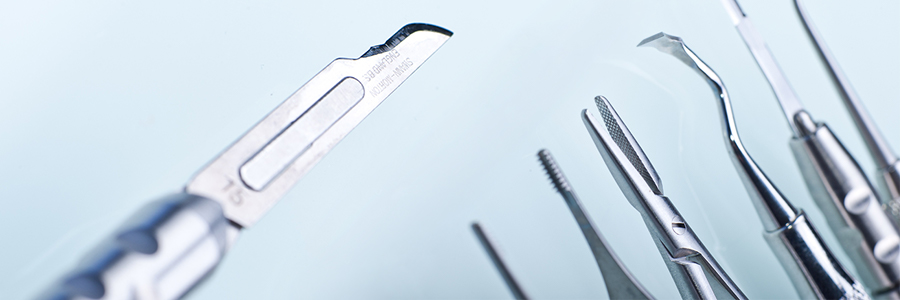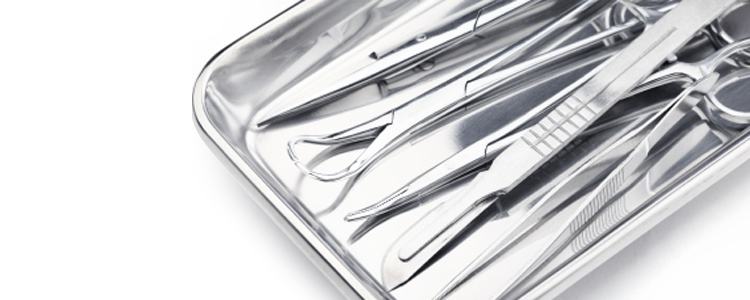Instrument Management and Protection

Technical and Regulatory Information
Care and Handling of Surgical Hand Instruments

Surgical Instruments: Indications for use
Surgical Instruments are engineered to perform specific functions. Achieving hemostasis by clamping, sharp, and dull dissection, grasing of tissue, or implants, probing, suctioning, or suturing are examples of specific functions. Individual patterns should be used only for the maneuvers they were designed to perform, by or under the supervision of a qualified surgeon.
Contraindications
Instruments should not be used for any purpose or maneuver other than what is their intended use.
Inspection and Caution
Invotec International provides surgical instruments as unsterile. All surgical instruments must be cleaned prior to sterilization and preparation (lubrication) for use. Upon receipt of a new instrument and after every cleaning, especially in an ultrsonic cleaner, all joints and screws should be checked, tightened, and lubricated. Failure to follow a cleaning and inspection protocol could lead to damage and failure of the instrument.
Reprocessing and Resterilization of Invotec Products
A.A.M.I Standards and Recommended Practice, Safe Handling and Biological Decontamination of Medical Devices in Heath Care Facilities and in Non-Clinical Settings, ANSI/AAMI ST35:2003, keeping in mind this process is in two steps: 1. Complete cleaning and 2. Washing and Sterilization.
Decontamination of Surgical Instruments
Cleaning during and following the surgical procedure
During a surgical procedure, the scrub nurse should wipe accumulated blood from all instruments surfaces, especially jaw serrations, joints and box locks. Following the procedure, it is important to rinse used surgical instruments, before they dry, with sterile water as blood and salt solutions are very corrosive.
Cleaning of Used Surgical Instruments
Biofilm is now a consideration in the management and cleaning of surgical instruments. This accumulation of biomass, by bacteria and fluid, colonizes the surface area of dried instruments. Biofilms are difficult to remove and decontaminate, especially within the extended lumens of suction tips, trocars, and irrigation channels.
Asceptic Procedure # 1
The wiped down, yet soiled instruments must be kept moist in prior too formal cleaning and terminal disinfection. Draping the soiled instruments with a distilled water-soaked towel or covering the patterns with commercial available gels, or sprays will maintain moist patten surfaces.
Use of an Enzymatic Cleaning Solution
There are a number of enzymatic cleaning solutions available that have been forumulated specifically for stainless steel surgical instruments. This solution will break down protenous materials like blood and tissue remnants. Prepare and use the solution per the manufacturer’s guidelines.
Prior to emersing the instrument set, take apart those patterns that are designed to be broken down for cleaning and make sure suction tip lumens and guards have been cleared by brushing, irrigating until the fluid runs clear, and air pressure. Soak per solution manufacturer’s recommendations.
Post enzymatic soak, rinse, cleaning
If using a pressure instrument washing machine, please take care in following the manufacturer’s loading and stacking recommendations. A key ingrediant to proper cleaning and maintance of surgical instruments is the use of a pH neutral soap or detergent. Acid or base solutions can break down the oxide protective surface of passivated stailess steel and lead to pitting, staining, or rust.
When Hand washing instruments, particular attention should be given to lumens, box locks and srew joints. A selection of soft brushes is needed to throughly clean instruments.
Should ultrasonic cleaning be used, make sure to follow manufacturer’s settings and recommnedations. All forceps and hand instruments with box locks and hinges should be placed into the UC basket, “open”, to allow the action to clean tight spaces and grooves.
Final Rinse
The waters used for this treatment must not be saline mixed or tap water. Rather, use softened or deionized water as this solution will remove elements that will spot or pit instrument surfaces.
Decontamination
Instruments free of soil still need to be decontaminated to handling and inspection. If steam sterilized do not wrap the instruments.
Prior to drying the instruments, inspect for wear, damage, cracks, or rust. Lubricating the instruments by soaking in instrument milk will extend the life of moving parts, box locks, and hinges along with laying down a protective surface.
Sterilization
Should steam sterilization be used, please reference: AAMI Standards and Recommended Practices, “Steam Sterilization and Sterility Assurane in Health Care Facilities”, ANSI/AAMI ST46:2002; also Flash Sterilization Steam Sterilization of Patient care Items for Immediate Use, ANSI/AAMI ST37:3eed.
Instrument Sterilization
| Type of Sterilizer | Temperature | Time (Min) | Minimum Drying Cycle (Min) |
|---|---|---|---|
| Pre-vauum (wrapped) | 121° C (250° F) 132° C (270° F) 134° C (273° F) |
20 4 3 |
20 20 15 |
| Pre-vacuum (unwrapped) | 132° C (270 F°) | 4 | |
| Gravity Steam (wrapped) | 132° C (270° F) | 18 |
Instrument Management
Stainless steel instruments should not be soaked or covered with caustic materials. Materials and liquids that will damage surgicals instruments are:
Glutaraldehyde |
Ferric Chloride |
Saline |
Carbolic acid |
Phenol |
Aqua regia |
Hydrochloric acid |
Surfuric acid |
Barium chloride |
Chlorinated lime |
Dakins Sols |
Stannous chloride |
Sodium hypochlorite |
Potassium thiochanate |
Potassium permanganate |
Rusting and Stains
Instrument staining is not uncommon and usually affects only the pattern’s look, not function. Elements in the water, harsh chemicals, and incomplete cleaning all contribute to stains on instrument surfaces.
Stain or Condition |
Cause |
Fix |
Blue Surface |
Cold disinfection or sterilization, with the pattern potentially being left in solution longer than the recommended time. |
Robust rinse with distilled water and use of a rust inhibitor will help. |
Black Surface |
Using cleaning materials containing ammonia |
Robust rinse with distilled water and use of a rust inhibitor will help. |
Brown Surface |
Usually derived from copper deposits occurring within sterilizing chambers. |
Look into alternative washing liquids |
Rusting or |
ASTM quality stainless steel usually does |
Economy grade patterns are made from steel that may contain enough ferrous (Iron) to oxidize/rust. Care should be taken in comparing price to quality in surgical instruments. |